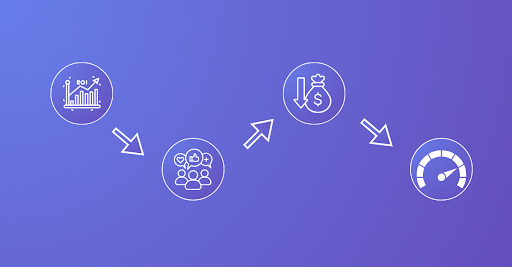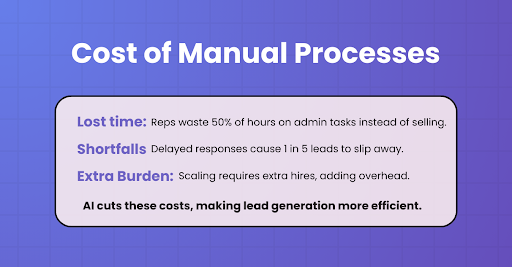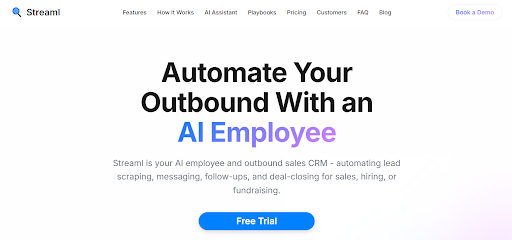AI vs. Traditional Lead Generation is one of the biggest decisions for B2B SaaS companies in 2025. The choice directly impacts Lead Generation ROI, scalability, and customer acquisition strategies. AI-powered lead generation uses data-driven lead scoring and predictive analytics to automate outreach, personalize communication, and improve conversions. Traditional lead generation relies on manual methods like cold calling and trade shows, which are slower and harder to scale. This guide compares both approaches and shows why AI-driven sales strategies deliver cost-effective lead generation and superior ROI.
Why Companies Are Shifting to AI-Powered Solutions

Businesses adopt AI-powered lead generation for four main reasons:
- Higher Returns: AI lead generation delivers up to 3x ROI compared to traditional methods (industry studies).
- Personalization: Personalized Outreach with AI boosts engagement by 25%, driving conversions.
- Scalability: B2B lead generation with AI without additional staff, reducing costs by 30%.
- Speed: Instant responses improve Conversion Rate by 20%.
AI-powered lead generation delivers faster, scalable, and more personalized results with up to 3x ROI compared to traditional methods.
Strengths and Weaknesses of Traditional Lead Generation
Traditional lead generation methods (e.g., cold calls, trade shows) have strengths but lag in ROI:
Strengths:
- Human touch for niche relationships.
- Familiar processes requiring minimal setup.
Weaknesses:
- Time-intensive, reducing the ROI of traditional lead generation.
- Limited scalability due to manual effort.
- Inconsistent personalization lowers conversion rates.
AI vs. Traditional Lead Generation: Pros and Cons
| Aspect | AI-Powered Lead Gen | Traditional Lead Gen |
|---|---|---|
| Pros | Data-Driven Lead Scoring, scalability, 3x ROI | Human expertise, low initial cost |
| Cons | Setup costs, data privacy needs | Slow, resource-heavy, low ROI |
AI lead scoring achieves 90% accuracy vs. 60–70% in traditional methods.
Head-to-Head Comparison: Efficiency and ROI
| Metric | Traditional Lead Gen | AI-Powered Lead Gen |
|---|---|---|
| Speed | Hours/days for outreach | Instant via Lead Generation Automation |
| Accuracy | 60-70% with manual scoring | 90%+ with AI lead scoring |
| Conversions | 5-10% | 20%+ with Personalized Outreach with AI |
| ROI | 1-2x return, limited by scale | 3x return with AI Lead Generation ROI |
It shows AI's superior Efficiency in lead generation and ROI.
The Hidden Costs of Manual Processes

Manual processes destroy Traditional Lead Generation ROI:
- Time Costs: Reps spend 50% of time on admin tasks, delaying deals.
- Opportunity Costs: Slow responses lose 20% of leads, per research.
- Hiring Costs: Scaling requires additional staff, increasing expenses.
AI reduces time, hiring, and opportunity costs, making it a more cost-effective lead generation strategy.
AI Lead Generation Techniques for Improved ROI
- Automating Lead Scoring: AI lead scoring vs. traditional lead scoring achieves 90% accuracy, boosting conversions.
- Enriching Lead Data: Pulls insights from LinkedIn and websites, improving targeting precision.
- Intelligent Routing: Directs leads to reps, enhancing Sales Funnel Optimization and ROI.
Enhancing Lead Engagement with AI
AI drives engagement, directly impacting AI Lead Generation ROI:
- Personalized Outreach Through AI: Tailored emails increase open rates by 25%.
- Omnichannel Integration: Syncs with AI-powered CRM, email, and LinkedIn for seamless B2B lead generation with AI.
Cost Reduction Through Automation
AI tools automate 60% of prospecting tasks and reduce hiring costs by 30%, delivering 3x ROI over traditional methods.
AI for Strategic Decision Making
AI enhances ROI through:
- Predictive Analytics for Lead Nurturing: Forecasts lead behavior, improving conversion rates by 20%.
- Data-Driven Decisions: Dashboards optimize Customer Acquisition Strategies.
Maximizing ROI with AI and Human Expertise
A hybrid model combines:
- AI Strengths: Lead Generation Automation and Data-Driven Lead Scoring for efficiency.
- Human Expertise: Relationship-building for high-value deals.
Example: AI handles initial outreach; humans close complex deals, boosting AI vs. Traditional Lead Gen ROI.
Challenges of Implementing AI Lead Generation
Key hurdles:
- Technical Barriers: Overcome with platforms like Streaml, minimizing setup costs.
- Data Privacy: GDPR/CCPA compliance ensures secure B2B lead generation with AI.
Cost-Benefit Analysis and Long-Term ROI
| Approach | Initial Cost | Long-Term ROI |
|---|---|---|
| Traditional | $5,000-$10,000/year (labor) | 1-2x, limited by scale |
| AI-Driven | $50-$200/user/month | 3x, driven by Cost-Effective Lead Generation |
AI vs. Traditional Lead Gen ROI shows AI's scalability and cost savings deliver superior returns.
Real-World Applications: Streaml and MyUser
Streaml: Automated AI-Powered Prospecting, generating 150+ leads monthly, yielding 22% Conversion Rate Improvement and 3x ROI.

MyUser: Used Data-Driven Lead Scoring to boost lead quality by 30%, doubling AI Lead Generation ROI.
The Future of Lead Generation
By 2026, 65% of B2B firms will adopt AI-powered lead generation, per Gartner. Trends include:
- Generative AI: Dynamic content for Personalized Outreach with AI.
- AI Supercharges Lead Scoring Precision: Enhances AI lead scoring vs. traditional lead scoring.
Conclusion
AI vs. Traditional Lead Gen proves AI's dominance in AI Lead Generation ROI, offering speed, accuracy, and Cost-Effective Lead Generation. For B2B lead generation with AI, tools like Streaml drive Sales Funnel Optimization. Start with a pilot to maximize ROI in 2025. Explore AI tools for lead generation like Streaml to transform your outbound strategy.